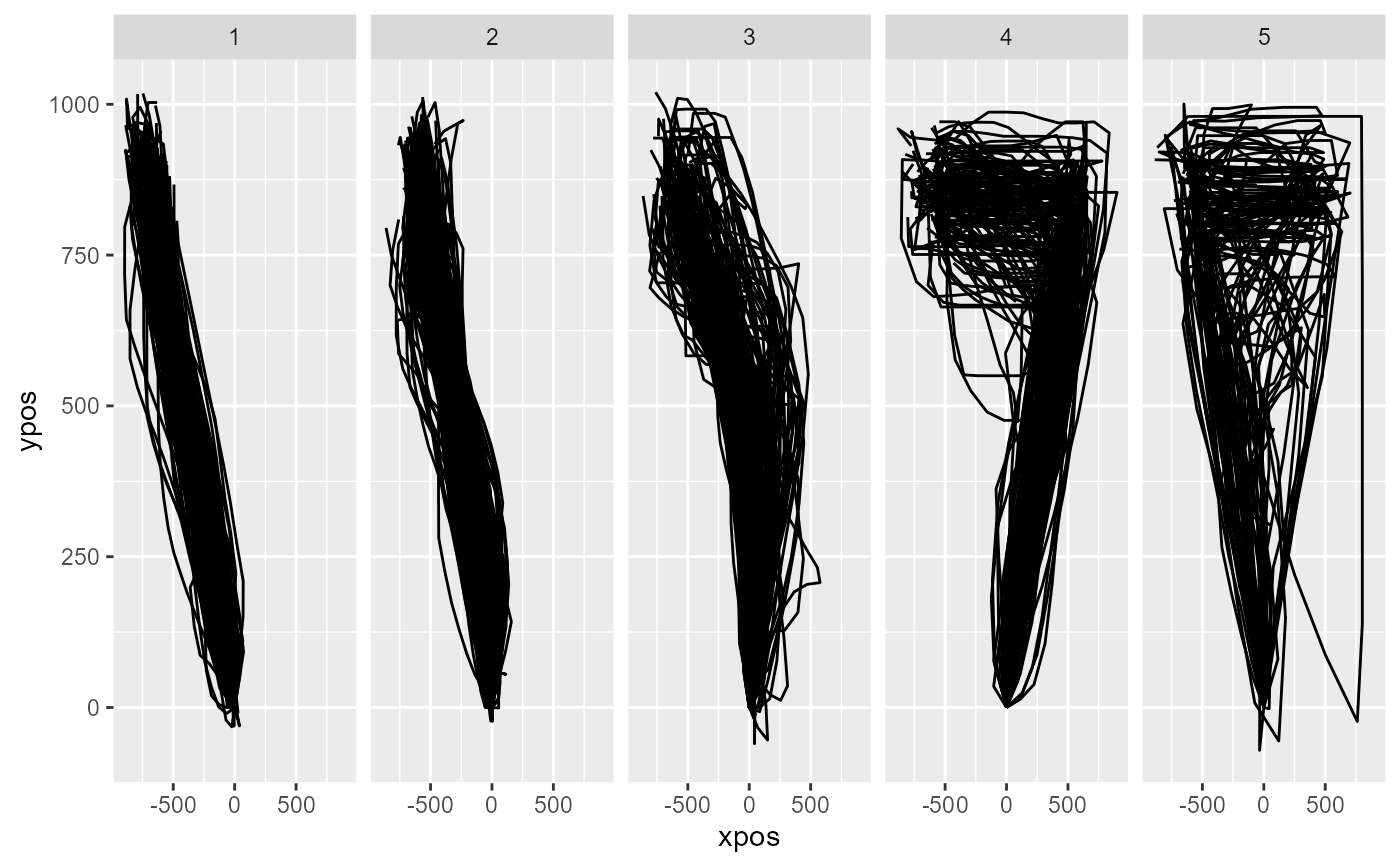Performs trajectory clustering. It first computes distances between each pair of trajectories and then applies off-the-shelf clustering tools to explain the resulting dissimilarity matrix using a predefined number of clusters.
mt_cluster(
data,
use = "ln_trajectories",
save_as = "clustering",
dimensions = c("xpos", "ypos"),
n_cluster = 5,
method = "hclust",
weights = rep(1, length(dimensions)),
pointwise = TRUE,
minkowski_p = 2,
hclust_method = "ward.D",
kmeans_nstart = 10,
na_rm = FALSE,
cluster_output = FALSE,
verbose = FALSE
)Arguments
- data
a mousetrap data object created using one of the mt_import functions (see mt_example for details). Alternatively, a trajectory array can be provided directly (in this case
usewill be ignored).- use
a character string specifying which trajectory data should be used.
- save_as
a character string specifying where the resulting data should be stored.
- dimensions
a character vector specifying which trajectory variables should be used. Can be of length 2 or 3, for two-dimensional or three-dimensional trajectories respectively.
- n_cluster
an integer specifying the number of clusters to estimate.
- method
character string specifying the clustering procedure. Either hclust (the default) or kmeans.
- weights
numeric vector specifying the relative importance of the variables specified in
dimensions. Defaults to a vector of 1s implying equal importance. Technically, each variable is rescaled so that the standard deviation matches the corresponding value inweights. To use the original variables, setweights = NULL.- pointwise
boolean specifying the way in which dissimilarity between the trajectories is measured. If
TRUE(the default),mt_distmatmeasures the average dissimilarity and then sums the results. IfFALSE,mt_distmatmeasures dissimilarity once (by treating the various points as independent dimensions). This is only relevant ifmethodis "hclust". See mt_distmat for further details.- minkowski_p
an integer specifying the distance metric for the cluster solution.
minkowski_p = 1computes the city-block distance,minkowski_p = 2(the default) computes the Euclidian distance,minkowski_p = 3the cubic distance, etc. Only relevant ifmethodis "hclust". See mt_distmat for further details.- hclust_method
character string specifying the linkage criterion used. Passed on to the
methodargument of hclust. Default is set toward.D. Only relevant ifmethodis "hclust".- kmeans_nstart
integer specifying the number of reruns of the kmeans procedure. Larger numbers minimize the risk of finding local minima. Passed on to the
nstartargument of kmeans. Only relevant ifmethodis "kmeans".- na_rm
logical specifying whether trajectory points containing NAs should be removed. Removal is done column-wise. That is, if any trajectory has a missing value at, e.g., the 10th recorded position, the 10th position is removed for all trajectories. This is necessary to compute distance between trajectories.
- cluster_output
logical. If
FALSE(the default), the mousetrap data object with the cluster assignments is returned (see Value). IfTRUE, the output of the cluster method (kmeansorhclust) is returned directly.- verbose
logical indicating whether function should report its progress.
Value
A mousetrap data object (see mt_example) with an additional
data.frame added to it (by default called clustering) that
contains the cluster assignments. If a trajectory array was provided
directly as data, only the clustering data.frame will be
returned.
Details
mt_cluster uses off-the-shelf clustering tools, i.e.,
hclust and kmeans, for cluster estimation.
Cluster estimation using hclust relies on distances
computed by mt_distmat.
Mouse trajectories often occur in distinct, qualitative types (see Wulff et
al., 2019; Wulff et al., 2022). Common trajectory types are linear
trajectories, mildly and strongly curved trajctories, and single and multiple
change-of-mind trials (see also mt_map). mt_cluster can tease
these types apart.
mt_cluster uses hclust or kmeans to
explain the distances between every pair of trajectories using a predefined
number of clusters. If method is "hclust", mt_cluster computes the
dissimiliarity matrix for all trajectory pairs using mt_distmat. If
method is "kmeans", this is done internally by kmeans.
We recommend setting method to hclust using
ward.D as the linkage criterion (via hclust_method). Relative
to kmeans, the other implemented clustering method, and other
linkage criteria, this setup handles the skewed distribution cluster sizes
and trajectory outliers found in the majority of datasets best.
For clustering trajectories, it is often useful that the endpoints of all trajectories share the same direction, e.g., that all trajectories end in the top-left corner of the coordinate system (mt_remap_symmetric or mt_align can be used to achieve this). Furthermore, it is recommended to use length normalized trajectories (see mt_length_normalize; Wulff et al., 2019, Wulff et al., 2023).
References
Wulff, D. U., Haslbeck, J. M. B., Kieslich, P. J., Henninger, F., & Schulte-Mecklenbeck, M. (2019). Mouse-tracking: Detecting types in movement trajectories. In M. Schulte-Mecklenbeck, A. Kühberger, & J. G. Johnson (Eds.), A Handbook of Process Tracing Methods (pp. 131-145). New York, NY: Routledge.
Wulff, D. U., Kieslich, P. J., Henninger, F., Haslbeck, J. M. B., & Schulte-Mecklenbeck, M. (2023). Movement tracking of psychological processes: A tutorial using mousetrap. PsyArXiv. doi:10.31234/osf.io/v685r
Wulff, D. U., Haslbeck, J. M. B., & Schulte-Mecklenbeck, M. (2022). Measuring the (dis-)continuous mind: What movement trajectories reveal about cognition. Manuscript in preparation.
See also
mt_distmat for more information about how the distance matrix is computed when the hclust method is used.
mt_cluster_k for estimating the optimal number of clusters.
Examples
# Length normalize trajectories
KH2017 <- mt_length_normalize(KH2017)
# Cluster trajectories
KH2017 <- mt_cluster(KH2017, use="ln_trajectories")
# Plot clustered trajectories
mt_plot(KH2017,use="ln_trajectories",
use2="clustering",facet_col="cluster")
